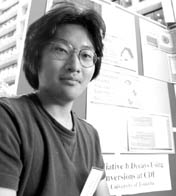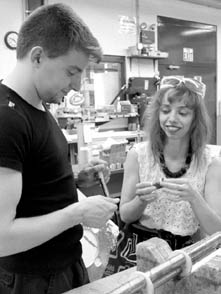 |
 New Perspectives, the annual conference of Fermilab's graduate students, got underway at an evening reception on July 8, with the first annual poster contest, organized by the Fermilab Graduate Student Association. Named in honor of the late George Michail, a Fermilab graduate student from Harvard who was killed in a car crash in 1996, the contest brought together the work of students from all corners of the Laboratory. Their posters addressed subjects from the flavors of charm to the measurement of magnetization in superconducting wire and drew a large and interested audience in the Wilson Hall atrium. A team of five Fermilab physicists chose first-, second- and third-place winners, who received certificates and cash awards contributed by Universities Research Association, Inc. New Perspectives, the annual conference of Fermilab's graduate students, got underway at an evening reception on July 8, with the first annual poster contest, organized by the Fermilab Graduate Student Association. Named in honor of the late George Michail, a Fermilab graduate student from Harvard who was killed in a car crash in 1996, the contest brought together the work of students from all corners of the Laboratory. Their posters addressed subjects from the flavors of charm to the measurement of magnetization in superconducting wire and drew a large and interested audience in the Wilson Hall atrium. A team of five Fermilab physicists chose first-, second- and third-place winners, who received certificates and cash awards contributed by Universities Research Association, Inc.
In presenting the awards at the conference next morning, Director Michael Witherell told the students that one reason high-energy physicists are in demand to work in other fields is that they are trained to make the case for their ideas to their colleagues. He cited the poster contest as a case in point. New Perspectives '99, organized by the GSA's Maria Spiropulu of Harvard University, drew some 65 students as well as several of their elders, and featured invited talks by well-known physicists and reports on research by the students themselves. "It's a good opportunity to talk about your work informally, even if you don't yet have a result that's been blessed [by the experiment collaboration]," said Purdue University's Arnold Pompos. "Other people are interested in what you're doing at the lab." Two dozen students presented talks on subjects including boson production at DZero, searches for supersymmetry at CDF, and recent results on CP violation from KTeV. Fermilab theorist Chris Quigg introduced his former thesis advisor and the conference's keynote speaker, Professor J.D. Jackson of the University of California at Berkeley. Jackson is well known to generations of physicists as the author of the classic text, "Classical Electrodynamics." Jackson said he is concerned about a tendency toward increasing specialization and its impact on the unity of physics, calling for both university faculty and students to widen their focus by, for example, attending physics colloquia on diverse topics. In a live demonstration, Jackson poured honey from a plastic bear. He squeezed the bear to change the rate of honey flowing out and explained how to derive the frequency of the resulting coils of honey using dimensional analysis. "I thought his talk was exhilarating," Spiropulu said. "It made me wish I would be like Professor Jackson one day."
The conference's final speaker, theorist Joe Lykken, told the students that high-energy physics is exciting and will remain exciting precisely because it exists in a state of permanent revolution.
"Something is out there," Lykken exhorted them. "Go find it."
|
| last modified 7/23/1999 email Fermilab |
FRLsDFx9eyfrPXgV
 Other invited speakers included Quigg, Fermilab astrophysicist Rocky Kolb, DZero cospokesman Hugh Montgomery, Harvard graduate student Marc Hill, and University of Wisconsin physicist Francis Halzen. CDF's Alvin Tollestrup made an extemporaneous plea to the students not to neglect the study of accelerator physics.
Other invited speakers included Quigg, Fermilab astrophysicist Rocky Kolb, DZero cospokesman Hugh Montgomery, Harvard graduate student Marc Hill, and University of Wisconsin physicist Francis Halzen. CDF's Alvin Tollestrup made an extemporaneous plea to the students not to neglect the study of accelerator physics.